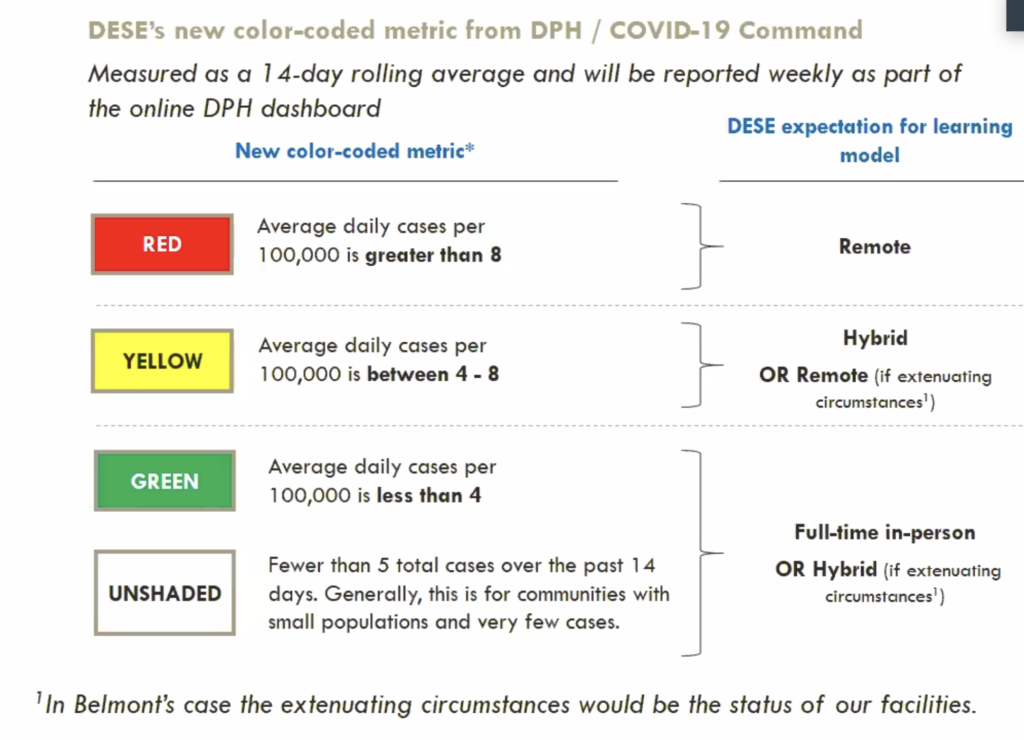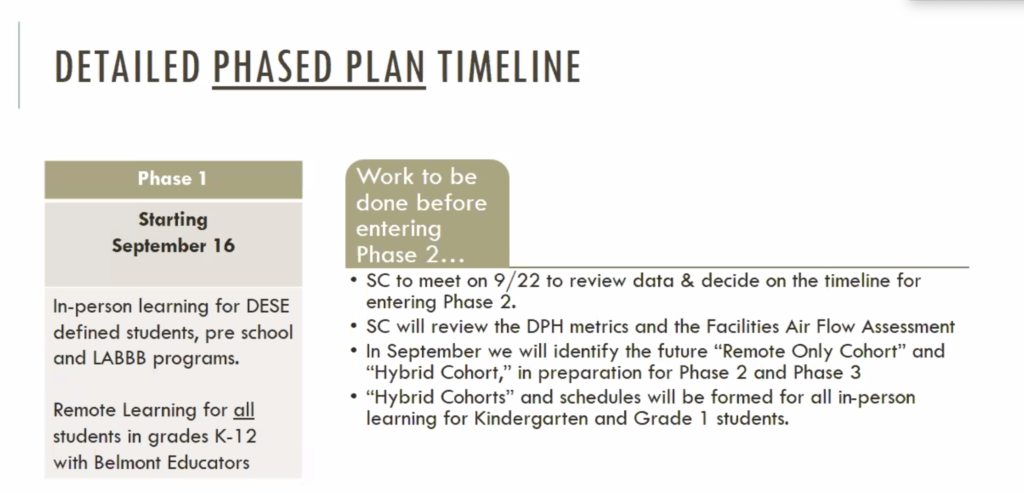Photo: One hundred years ago, New York City schools opened school building windows to effectively fight the “Spanish flu” pandemic. (Library of Congress)
In a recent survey of Belmont parents, 67 percent were in favor of opening the school in hybrid or in-person. Questions remain: Is the time now to reopen Belmont school in the hybrid? Is there a right way for opening Belmont schools?
The case for reopening schools is simple. Kids learn better in schools; remote learning is less effective and is disproportionately felt by lower-income students and students with fewer resources. The CDC and mental health experts agree that schools should open this fall. The psychological toll on children is mounting, and school closing, quarantining and isolation are contributing to long-lasting effects on children. The data from Europe and Asia are encouraging. They reopened schools and, while they’ve seen cases of COVID, they haven’t seen schools as major vectors of infection. These offer real-world evidence to inform our strategies for school opening. In a recent analysis of the risk associated with school opening, the authors concluded that reopening schools will not significantly increase community-wide transmission, provided sufficient school-based interventions are implemented. Moreover, when the incidence rate in the community is at or below 20 per 100,000, Belmont is significantly lower than this threshold, the risk of infection in schools is less than one percent.
How we reopen schools matters. Florida is a great example of how NOT to reopen schools given its rising levels of infections. We support the risk assessment metrics set by Massachusetts Gov. Charlie Baker for school opening. The rate of infection in Massachusetts is low despite the fact that more people are socializing outdoors, going to restaurants and nail salons, driving to work, shopping, or leisure. While there will never be enough testing, we can’t let perfect be the enemy of the good. There has been an uptick in testing in Belmont and the State, and, importantly, the rate of infection remains low and stable since June (Figure 1). At the local level, Belmont and all the neighboring towns remain in “green” or “white” (see Table 1) further reducing the risk of infection at schools. These are all encouraging signs and if Belmont were to follow the DESE recommendation, schools would reopen now. So why is Belmont not opening in hybrid?
It’s Time to Reopen Belmont Schools
| Town | Risk based on average daily cases per 100,000 | Positive cases last 14 days | % positive last 14 days | % Trend |
| Belmont | Green | 9 | 0.66 | No change |
| Watertown | Green | 15 | 0.8 | Lower |
| Cambridge | Green | 34 | 0.88 | No change |
| Waltham | Green | 34 | 0.88 | No change |
| Arlington | White | 5 | 0.21 | No change |
| Lexington | White | 3 | 0.24 | No change |
It is not lost on us that assessing the risk-benefit of opening schools in the middle of a pandemic is as much a scientific and policy question, as it is personal. At the heart of it, advocates of opening the schools are looking at the data and are saying we are making the uncomfortable judgment that taking a risk with someone’s health is OK in order for us to have these benefits. In the middle of an acute crisis, history has taught us that there is a tendency to be overly conservative and want to institute extreme safety measures. On balance and with the benefit of retrospective analysis, extreme measures have rarely been effective at keeping us safe. The question is therefore how much risk are you willing to tolerate? Zero risks are not only unachievable, but it rarely makes for a good strategy or informed public policy.
As Belmontians, we make these calculations all the time. We allow our teenagers to drive cars, our pre-teens to walk to Belmont’s Underwood pool, ride their bikes to the town center, and partake in a variety of other activities that have some inherent risk. So in trying to answer how large are the potential health risks, we need to anchor the discussion in what the evidence above says, how large are the potential benefits, and the long-term impact on kids, in addition to the immediate impact on their parents, their teachers and the economy.
We take the risk to teachers and staff seriously. To that effect, we want to end with a positive example that showcases the power of engagement with the Belmont parent community.
Much of the discussion, especially in Belmont social media circles, has been productive, but understandably visceral when it comes to how much risk people are willing to take and how it affects teachers and staff. The school district, the Massachusetts Teachers Association, and the Belmont School Committee have identified air quality as an area of major concern for opening the school. This is not an unexpected request given that the District has already run similar analyses in the past. A solution that requires the building of new schools or upgrading all HVAC systems is costly and unrealistic options as preconditions for opening schools. Two Belmont parents authored a well researched white paper that suggested a simple, cost-effective solution to mitigate the air quality concern. To his credit, Belmont School Superintendent John Phelan met with the parents and ordered 150 portable commercial filters that can be deployed as early as next week. Further, the group highlighted the results of a study done by a group from Harvard University’s T.H. Chan School of Public Health that showed that opening a window as little as six inches can provide superior air exchange and be used as an effective strategy to augment mechanical-based solutions to air quality control. In listening to issues like air quality that are central to the School Committee, the superintendent, and the MTA decision to reopening schools, the community has demonstrated how it can act as an effective resource to solve critical problems and support the need for a resource-constrained school district.
The community is actively listening and wants to be part of the solution. The time is now to go to hybrid. We urge the school committee to accelerate the timetable for opening the school in hybrid. Let’s give our kids an opportunity to work together with their peers and their teachers, even if it were for a short time while Belmont is in the “green” zone. The benefits to their psychological well being and educational equity will be immeasurable. Let’s avoid creating obstacles that are red herrings, and keep the decision for opening the schools science-driven and anchored in the state guidelines and local data.
Jamal Saeh, Larry Schmidt, Martin Zwierlein, Kerry O’Grady, Maysoun Shomali, Patrick Whittemore, Christine McLaughlin, David Thesmar, Mikhail Zaslavsky, Ron Creamer, Carrie Bryan, Christine Regan, Liane Brecknock, Pamela Schmidt, Valerie Krempus, Robi Krempus, Danielle Lemack, Karl Ivester, Sonya Santos, Maíra Rejane Marques Samary, Alex Danahy, Olga Shyshko, Kelley Moriarty, and Alicia Dimitruk

